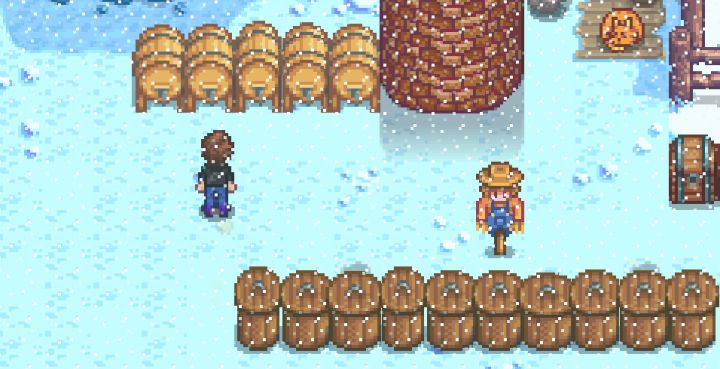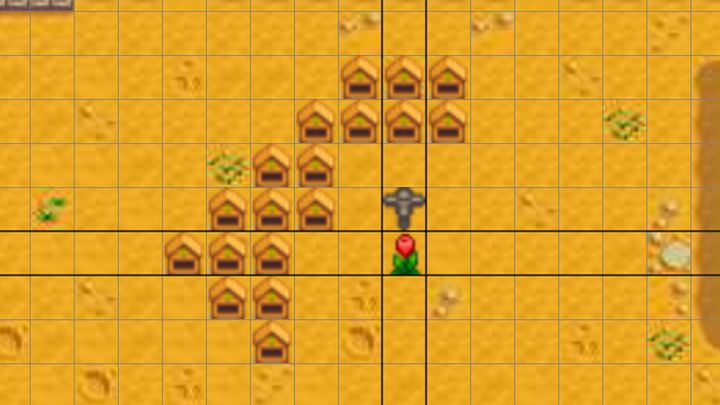Stardew Valley: Artisan Goods
Making Specialty Goods from Materials and Produce
 The preserves jar makes jelly and pickles, while kegs make wine, beer, juice, and pale ale. Artisan crafting lets you make goods more valuable, instead of selling them raw.
The preserves jar makes jelly and pickles, while kegs make wine, beer, juice, and pale ale. Artisan crafting lets you make goods more valuable, instead of selling them raw.
Players may, of course, sell raw produce and materials they create in Stardew Valley. However, you can take it one step further and create Artisan Goods by using your fresh ingredients. Items like cheese, beer, cloth, and wine sell for a higher value due to the extra time put into them. The following is a list of all the artisan crafting stations you can make in Stardew Valley, what types of items they accept, how long it takes, and how much more money you'll make.
How It Works
Access the crafting tab (Esc) and build one or more of the artisan objects listed below. Preferably the right amount you need based on capacity. Place goods inside by holding them and clicking the building, and you'll automatically start the structure's timer. When it's done, you can click to harvest the Artisan Goods.
Tappers and Bee Houses make their goods on their own and only require you to harvest, while others require a fruit, vegetable, or other product to function. Making artisan goods is a very good idea during Stardew Valley's winter, assuming you've saved up items to convert. It's a chance to make extra money during the worst season of the year.
None of these are affected by the initial quality of ingredients you use. Some of these don't have star-quality values, others do. Players who take Tiller as their farming level 5 profession get to choose the Artisan profession at level 10 that increases the price of artisan goods by 50% - this includes pretty much everything in this list.
In many cases, you can use the pickaxe to relocate these crafting stations and put them in a more desireable area. All estimates for the time it takes to make something are inexact, and may sometimes come up to 1 day earlier.
Ale, Beer, Wine and Juice
Make With: Keg (Farming Level 8)
Each Keg Requires Wood (30), Clay, Copper Bar, Iron Bar, Oak Resin
Production Time: 2 Days (Beer/Pale Ale), 4 Days (Juice), and 7 days (Wine)
The Ale is a workhorse and will help you get double or triple your value out of fruits, vegetables, wheat and hops you produce on the farm. Beer is made by placing wheat inside, Pale Ale is the product of hops. Juice is made using any vegetable, and wine is made with any fruit. Only place expensive fruits inside for wine, given how long it takes and that your keg is tied up until it's done. See tappers below for how to get Oak Resin. Beer and Pale Ale sell for 200 and 300g. Juice is 2x the vegetable's base value, and Wine is 3x the fruit's base value.
Cheese and Goat Cheese
Make With: Cheese Press (Farming Level 6
Each Cheese Press Requires: Wood (45), Stone (45), Hardwood (10), Copper Bar
Production Time 3 hours
The cheese press takes regular cow and goat milk and turns it into cheese. You'll get plenty of hardwood when you upgrade your axe to steel and can access the secret woods, so making as many presses as you have cows becomes possible. The other needed materials are trivial. Goat cheese is worth more (up to 450G) but you only get half as much goat milk as you do cow's milk. Making either type into cheese earns you 30-50% more than you'd get out of the raw product. It is worth pointing out that cheese is an excellent healing item for exploring the mines.
Cloth
Make With: Loom (Farming Level 7)
Each Loom Requires: Wood (60), Fiber (30), Pine Tar
Production Time: 4 Hours
The loom makes wool you've gained from sheep (reliable, every morning) and rabbits (random chance of dropping) and makes it into cloth, which sells for a flat 375g. It's certinaly possible to set up a number of these and keep them working to make cloth for you. Make an amount equal to the number of sheep you have, shear them every morning at feeding time, and put the wool on the loom.
Honey
Make With: Bee House (Farming Level 3)
Each Bee House Requires: Wood (40), Coal (8), Iron Bar, Maple Syrup.
Production Time: 4 Days
Plant a flower near a bee house (within 5x4 tiles) and the bees will automatically work to produce honey. Multiple Bee hives can work a lone flower, so you can surround just one flower with bees houses then harvest the honey every 4 days. Place a sprinkler next to the flower to make it hands-off.
 Make sure you can count 5 squares away from the bees to the flower. Also ensure that your farmer can get within 1 tile in order to harvest the honey. Remember, you can harvest 1 square diagonally!
Make sure you can count 5 squares away from the bees to the flower. Also ensure that your farmer can get within 1 tile in order to harvest the honey. Remember, you can harvest 1 square diagonally!
Efficient design means placing the flower in the center and surrounding it with bee houses. As you can see above, you'd be able to reach all of the beehives in order to harvest honey, and also change out the flower depending upon the season. The amount of money generated by the honey is based upon the flower you used. The most profitable types, by season, are Blue Jazz (Spring), Poppy (Summer), and Fairy Rose (Fall). Faster-growing flowers produce a less-profitable honey. Plant them on day one of the season and you'll get more honey out of it. Bees won't produce honey during winter, so there's no point in putting them in the Greenhouse.
Jelly and Pickles
Make With: Preserves Jar (Farming Level 4)
Each Preserves Jar Requires: Wood (50), Stone (40), Coal (8)
Production Time: 2 Days
The preserves jar is great for low-value fruit and vegetables. Preserves or Pickles will be created based up which kind you put inside. It's not hard to make a long row of preserve jars and have them working constantly. Pickles and Jelly sell for 50 + 2x the base value of the produce you put inside.
Maple Syrup, Oak Resin, and Pine Tar
Make With: Tappers (Foraging Level 3)
Each Tapper Requires: Wood (40), Copper Bar (2)
Production Time: 8 days (maple), 7 days (oak), 5 days (pine)
Tappers can be placed on one of the three types of trees and will give you the loot based upon where it's mounted. Creating a number of these and hanging them on trees is recommended to help you get them in quantity for use as crafting and cooking materials. The raw goods do sell quite well (200g for maple syrup) given you only need to visit a tree once in a while to get them.
You can create farms for these by planting rows of trees with two-block gaps between them, keeping the area clear, and mounting tappers when they're matured (which takes about 12 days). Tappers can be removed by hitting the tree one time with the axe.
Mayonnaise
Make With: Mayonnaise Machine (Farming Level 2)
Each Mayo Machine Requires: Wood (15), Stone (15), Earth Crystal, Copper Bar
Production Time: 3 Hours
Eggs' value can be quadrupled by using the Mayonnaise machine, and it gets done well inside one in-game day so you can make it multiple times if you have enough eggs stockpiled. Duck eggs create a more valuable mayonnaise, which can be worth 450g for gold-star quality.
Oil
Make With: Oil Maker (Farming Level 8)
Each Oil Maker Requires: Slime (50), Hardwood (20), Gold Bar
Production Time: 6 Hours for Truffle Oil, 2 Days for Oil (cooking)
The oil maker accepts corn, sunflower, and sunflower seeds to make oil. The sunflowers are a renewable source, since they drop seeds when harvested. This one is listed because it is indeed an artisan good, but it's not very profitable. Neither type is worth much more than the base value of the produce, and especially not when they're gold-star quality. Cooking oil can be bought, making your own is moderately useful. Truffle oil can be used to make rain totems (though they're expensive one-shot items).
